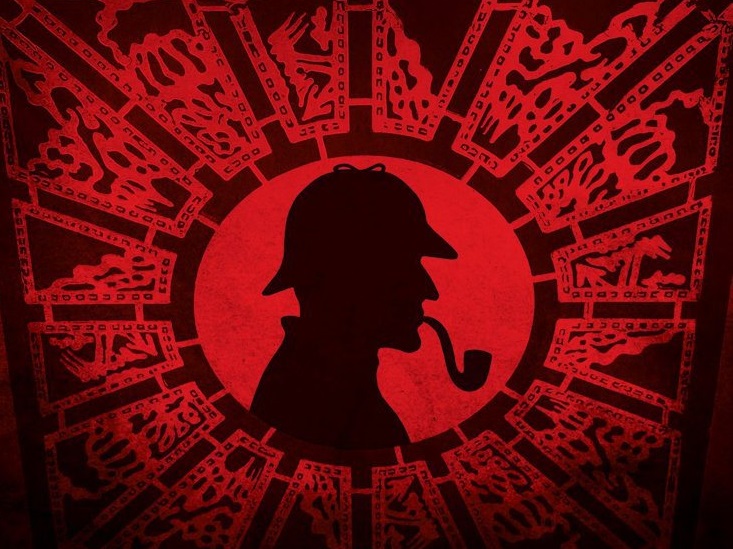
Sherlock Holmes and the Servants of Hell
Writer: Paul Kane
Publisher: Solaris
Genre: Horror
A review by Amelia Wellman
 Crossovers might have started up as a sub-section of fanfiction but they’ve grown into legitimacy and now hold a prominent place in pop culture. There’s superheroes sharing universes and storylines, full television time slots dedicated to a specific block of shows intertwining stories (remember when Salem in Sabrina the Teenage Witch swallowed a time ball and sent Boy Meets World, You Wish, and Teen Angel all back in time?), and even different iterations of the same franchise getting together (see IDW’s Ghostbusters Get Real as a prime example). With Sherlock Holmes and the Servants of Hell, the latest addition to crossover culture pits Sir Arthur Conan Doyle’s Holmesian logic against the brutal, sadomasochistic Hellscape of Clive Barker’s Hellraiser!
Crossovers might have started up as a sub-section of fanfiction but they’ve grown into legitimacy and now hold a prominent place in pop culture. There’s superheroes sharing universes and storylines, full television time slots dedicated to a specific block of shows intertwining stories (remember when Salem in Sabrina the Teenage Witch swallowed a time ball and sent Boy Meets World, You Wish, and Teen Angel all back in time?), and even different iterations of the same franchise getting together (see IDW’s Ghostbusters Get Real as a prime example). With Sherlock Holmes and the Servants of Hell, the latest addition to crossover culture pits Sir Arthur Conan Doyle’s Holmesian logic against the brutal, sadomasochistic Hellscape of Clive Barker’s Hellraiser!
It is late 1895. Holmes is listless after Moriarty’s death and set on a path of self-destruction. When a series of missing person cases crop up, some of Holmes’ old life comes into him as he attempts to find out how people are disappearing from locked rooms. But this mystery goes far deeper than a few missing persons. As Watson and Holmes investigate, they learn about a shadowy organisation, spoken of only in whispers as The Order of the Gash. The clues point to a sinister asylum in France and the underworld of London. Though once Holmes comes into possession of a certain puzzle box, he descends into an entirely different underworld and comes face to face with the servants of Hell, the bringers of both pain and pleasure: the Cenobites. And they have such sights to show Sherlock.
Paul Kane is the author of Sherlock Holmes and the Servants of Hell. I can’t speak for his Sherlock Holmes credentials but as far as Hellraiser is concerned, no one is more knowledgeable about the universe except Clive Barker himself. Kane has written the non-fiction title The Hellraiser Films and Their Legacy and edited a full collection of Hellraiser short stories for the anthology Hellbound Hearts. Kane has also edited other anthologies of horror shorts in addition to writing many of his own. The man knows his way around a good scary story.
Sherlock Holmes and the Servants of Hell has the bulk of the narrative told through Watson’s account of the events. It’s the standard Holmesian set-up, though Kane baulks the standard for about a third of the book and brings us large chunks of the story through Sherlock’s perspective instead. The different perspectives are meant to help us learn more about Watson and Sherlock (depending whose head the current chapter is in) but having the story jump between the two of them ends up being my largest complaint to this story. In the last half of the book, as each chapter alternates from Watson to Sherlock to Watson to Sherlock, etc, we end up getting a lot of doubling back over action and plot we already saw through the other one’s eyes. When Sherlock solves the puzzle box and calls forth the Cenobites, we see the scene through his eyes, including physical descriptions of all the Cenobites. In the very next chapter, we see the same scene through Watson’s eyes, including his physical description of all the Cenobites that we literally just read about. There are small differences, but it’s all concerning the same subject matter, so pages upon pages (in certain chapters) don’t feel like they’re leading towards anywhere new.
Though the Sherlock/Watson dynamic flows strangely, Kane handles the Hellraiser side of the story nicely. The labyrinth of the Cenobites Hell is handled well, creating an atmosphere of never-ending insanity and the M.C. Escher proportions that are often seen throughout the series. While the Hellscape that comprises the last third of the book is well crafted and true to form, you never get that sense with Holmes’ Victorian London. Everything in London is forgotten in Kane’s haste to get to Hell! I can’t blame the man. Hellraiser has one of the richest mythologies in horror.
There are also touches that roll over from the movies that are described compellingly, especially concerning when the puzzle box is solved. The bell tolling in the distance, the blue light coming between slats in the wall, the rumbling and shaking as the Cenobites near. All clear, concise, and cohesive to the Hellraiser atmosphere. Kane also skillfully describes the lust people have for the puzzle box. The all encompassing need to solve it fits so perfectly with Sherlock’s obsessive compulsion to decipher mysteries. Though I’m not claiming to be an expert on Holmes. Much to my chagrin, I’ve never read a Sherlock Holmes story.
As popular a character as Sherlock Holmes is, I’ve never actually been all that intrigued by him. I’ve seen the Guy Ritchie movies, caught one or two episodes of Benedict Cumberbatch stalking around London as Holmes aggressively texting Moriarty, and would watch Sherlock Holmes in the 22nd Century as a child, though I don’t remember anything beyond the opening theme. My interest in Sherlock Holmes and the Servants of Hell comes from the other half of its crossover: Hellraiser. I’ve loved the blood-soaked, leather garbed world of Clive Barker’s Hellraiser since I saw the first movie at age eleven!
The Hellraiser series, based on Barker’s novella The Hellbound Heart, has earned a special place among classic horror flicks. Since the franchise’s creation in 1986, the puzzle box and Cenobites have been spawned in nine (soon to be ten) movies, comics, short stories, even some cancelled videogames and television projects. I love Hellraiser because it’s beautiful. Unlike other slasher flicks that concentrate on cheap thrills and tits, Hellraiser presents itself like dark poetry. Emulating Barker’s more lyrical, beautiful world of gore and pain into Doyle’s utilitarian, factual, Victorian world of science and deduction is no easy task. Kane succeeds in blending the two very different properties by approaching Sherlock Holmes and the Servants of Hell much differently than expected.
I thought Sherlock Holmes and the Servants of Hell would be a wholly original Cenobite-based tale that just happened to take place in a time and place around Sherlock Holmes. What was presented was not only a crossover but a mash-up. Characters familiar throughout the series make appearances: Julia, Larry, and Frank Cotton (Hellraiser) all appear as Juliet, Lawrence, and Francis. Dr. Channard (Hellraiser II) appears under the character’s original name of Malahide.
At first, I was a little put off by having the Cotton’s contact Sherlock Holmes to find Frank. For a chapter it seemed that I was just reading the first movie’s Victorian novelization and it left me wary of what the rest of the story would be. My wariness was unfounded though; the Cotton’s appearance ended up being only a small cameo that ended up bringing some fan-service, parallel timeline charm into this Hellraiser tale. This story definitely skews more towards Hellraiser but Kane’s ending (that I won’t even think of spoiling here) brings in some Sherlock fan-service that won’t disappoint.
The Verdict
This recommendation depends. If you’re a huge fan of both Sherlock Holmes and Hellraiser, I can confidently say that you’ll find enjoyment with Sherlock Holmes and the Servants of Hell. Any other level of fandom or if you’re a fan of one property but not the other (as I was with Hellraiser but not Sherlock Holmes) and you might have moments of waning interest or disappointment that something you love about one series isn’t being highlighted. The narrative does compensate for any knowledge you might be lacking on either franchise, but you’ll be dissatisfied if you go in looking for more Holmes than Hellraiser, as this definitely leans towards the horror franchise more than the Holmesian franchise.
So where does the verdict lie with Sherlock Holmes and the Servants of Hell? Buy It if you’re a huge fan of both properties. Check It Out if you’re a fan of one and are curious to see how the two worlds collide. Skip It if you want just a Sherlock Holmes tale.


